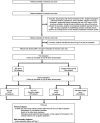Non-invasive ventilation versus oxygen therapy after extubation in patients with obesity in intensive care units: the multicentre randomised EXTUB-OBESE study protocol
- PMID: 35045999
- PMCID: PMC8772410
- DOI: 10.1136/bmjopen-2021-052712
Non-invasive ventilation versus oxygen therapy after extubation in patients with obesity in intensive care units: the multicentre randomised EXTUB-OBESE study protocol
Abstract
Introduction: Patients with obesity are considered to be at high risk of acute respiratory failure (ARF) after extubation in intensive care unit (ICU). Compared with oxygen therapy, non-invasive ventilation (NIV) may prevent ARF in high-risk patients. However, these strategies have never been compared following extubation of critically ill patients with obesity. Our hypothesis is that NIV is associated with less treatment failure compared with oxygen therapy in patients with obesity after extubation in ICU.
Methods and analysis: The NIV versus oxygen therapy after extubation in patients with obesity in ICUs protocol (EXTUB-obese) trial is an investigator-initiated, multicentre, stratified, parallel-group unblinded trial with an electronic system-based randomisation. Patients with obesity defined as a body mass index ≥30 kg/m² will be randomly assigned in the 'NIV-group' to receive prophylactic NIV applied immediately after extubation combined with high-flow nasal oxygen (HFNO) or standard oxygen between NIV sessions versus in the 'oxygen therapy group' to receive oxygen therapy alone (HFNO or standard oxygen,). The primary outcome is treatment failure within the 72 hours, defined as reintubation for mechanical ventilation, switch to the other study treatment, or premature study-treatment discontinuation (at the request of the patient or for medical reasons such as gastric distention). The single, prespecified, secondary outcome is the incidence of ARF until day 7. Other outcomes analysed will include tracheal intubation rate at day 7 and day 28, length of ICU and hospital stay, ICU mortality, day 28 and day 90 mortality.
Ethics and dissemination: The study project has been approved by the appropriate ethics committee 'Comité-de-Protection-des-Personnes Ile de FranceV-19.04.05.70025 Cat2 2019-A00956-51'. Informed consent is required. The results will be submitted for publication in a peer-reviewed journal and presented at one or more scientific conferences. If use of NIV shows positive effects, teams (medical and surgical) will use NIV following extubation of critically ill patients with obesity.
Trial registration number: NCT04014920.
Keywords: adult intensive & critical care; nutrition & dietetics; preventive medicine.
© Author(s) (or their employer(s)) 2022. Re-use permitted under CC BY-NC. No commercial re-use. See rights and permissions. Published by BMJ.
Conflict of interest statement
Competing interests: SJ reports receiving consulting fees from Drager, Medtronic, Baxter, Fresenius-Xenios, and Fisher & Paykel. ADJ reports receiving consulting fees from Medtronic. No potential conflict of interest relevant to this article was reported for other authors.
Figures
References
Publication types
MeSH terms
Substances
Associated data
LinkOut - more resources
Full Text Sources
Medical


